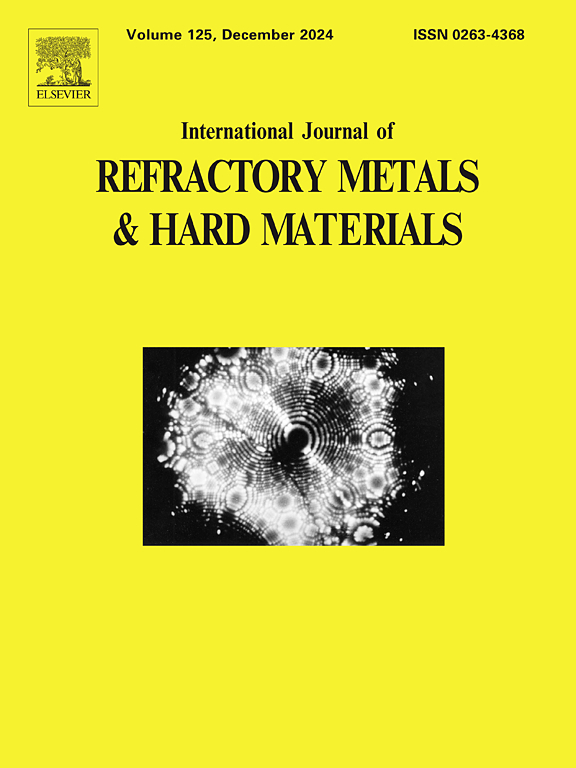A novel nitrogen-induced graded cemented carbides with γ'-strengthened binder phase
IF 4.2
2区 材料科学
Q2 MATERIALS SCIENCE, MULTIDISCIPLINARY
International Journal of Refractory Metals & Hard Materials
Pub Date : 2025-04-10
DOI:10.1016/j.ijrmhm.2025.107186
引用次数: 0
Abstract
The novel graded cemented carbides, with continuous variations in composition and phase, offers distinct functionalities to the surface and core. In the present work, a novel nitrogen-induced graded model cemented carbides with γ'-strengthened binder phase was systematically studied. Under the guidance of thermal analysis, the WC-Co-Ni-AlN-MC (M = Ta, Nb) graded model cemented carbides were sintered at 1320 and 1350 °C for 2 h under vacuum, respectively. The evolution of microstructure, elemental distribution, phase distribution and hardness was analyzed from the surface to the core. It was revealed that two different types of graded layers were formed by adjusting the sintering temperature. Meanwhile, the observed γ' phase significantly enhanced the microhardness of the binder phase. Consequently, the novel graded model cemented carbides with γ'-strengthened binder phase exhibited high hardness on the surface and high toughness in the core. Moreover, the migration and diffusion behavior of elements, as well as the formation mechanism of the graded structure, are elucidated. This work presents an innovative framework for the advancement of novel graded cemented carbides.

一种具有γ′强化粘结相的新型氮诱导梯度硬质合金
新型分级硬质合金,具有连续变化的成分和相,为表面和核心提供了独特的功能。本文系统地研究了一种具有γ′强化粘结相的新型氮诱导梯度模型硬质合金。在热分析的指导下,分别在1320℃和1350℃真空下烧结WC-Co-Ni-AlN-MC (M = Ta, Nb)梯度模型硬质合金2 h。分析了从表面到芯部的显微组织、元素分布、相分布和硬度的演变。结果表明,通过调节烧结温度可形成两种不同类型的梯度层。同时,观察到的γ′相显著提高了粘结剂相的显微硬度。因此,新型γ′强化结合相梯度型硬质合金具有高表面硬度和高芯韧性。此外,还阐明了元素的迁移和扩散行为以及梯度结构的形成机制。这项工作为新型梯度硬质合金的发展提供了一个创新的框架。
本文章由计算机程序翻译,如有差异,请以英文原文为准。
求助全文
约1分钟内获得全文
求助全文
来源期刊
CiteScore
7.00
自引率
13.90%
发文量
236
审稿时长
35 days
期刊介绍:
The International Journal of Refractory Metals and Hard Materials (IJRMHM) publishes original research articles concerned with all aspects of refractory metals and hard materials. Refractory metals are defined as metals with melting points higher than 1800 °C. These are tungsten, molybdenum, chromium, tantalum, niobium, hafnium, and rhenium, as well as many compounds and alloys based thereupon. Hard materials that are included in the scope of this journal are defined as materials with hardness values higher than 1000 kg/mm2, primarily intended for applications as manufacturing tools or wear resistant components in mechanical systems. Thus they encompass carbides, nitrides and borides of metals, and related compounds. A special focus of this journal is put on the family of hardmetals, which is also known as cemented tungsten carbide, and cermets which are based on titanium carbide and carbonitrides with or without a metal binder. Ceramics and superhard materials including diamond and cubic boron nitride may also be accepted provided the subject material is presented as hard materials as defined above.

 求助内容:
求助内容: 应助结果提醒方式:
应助结果提醒方式:


